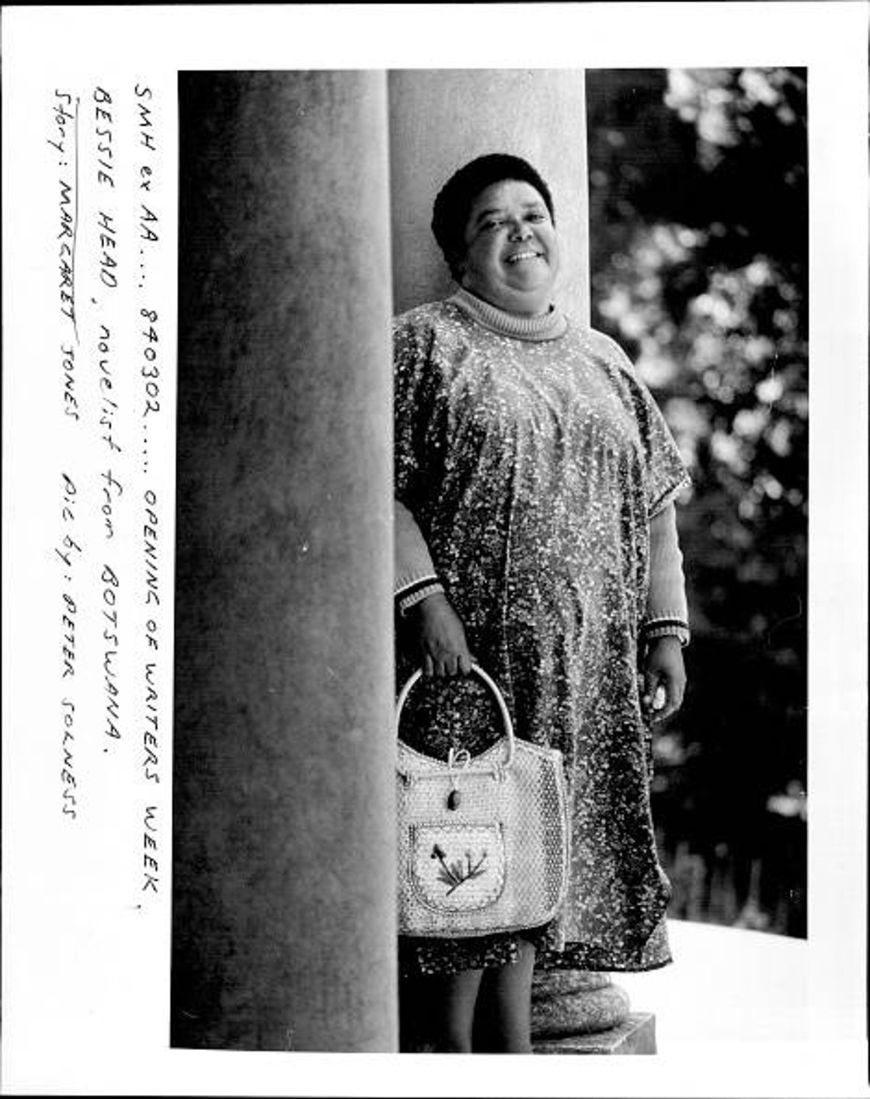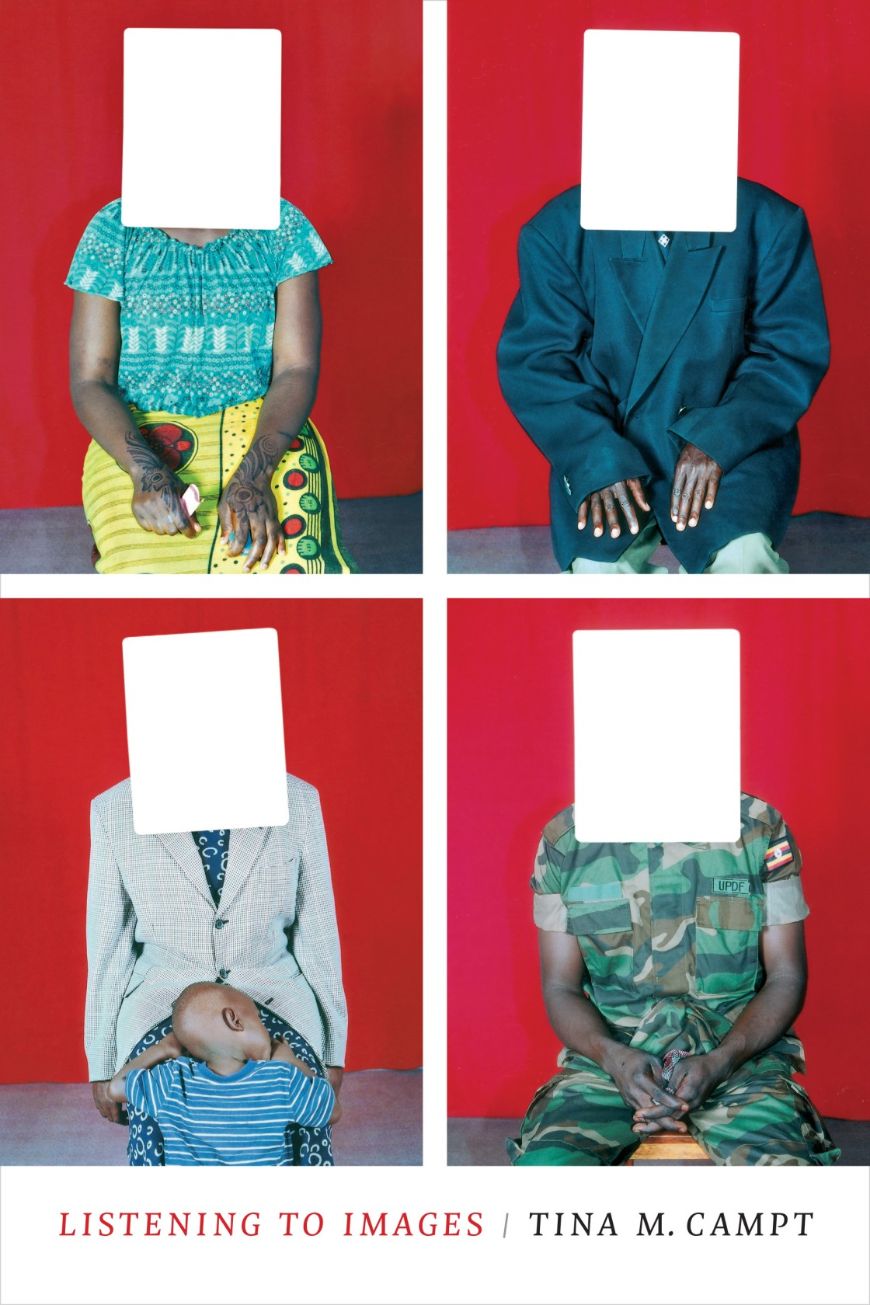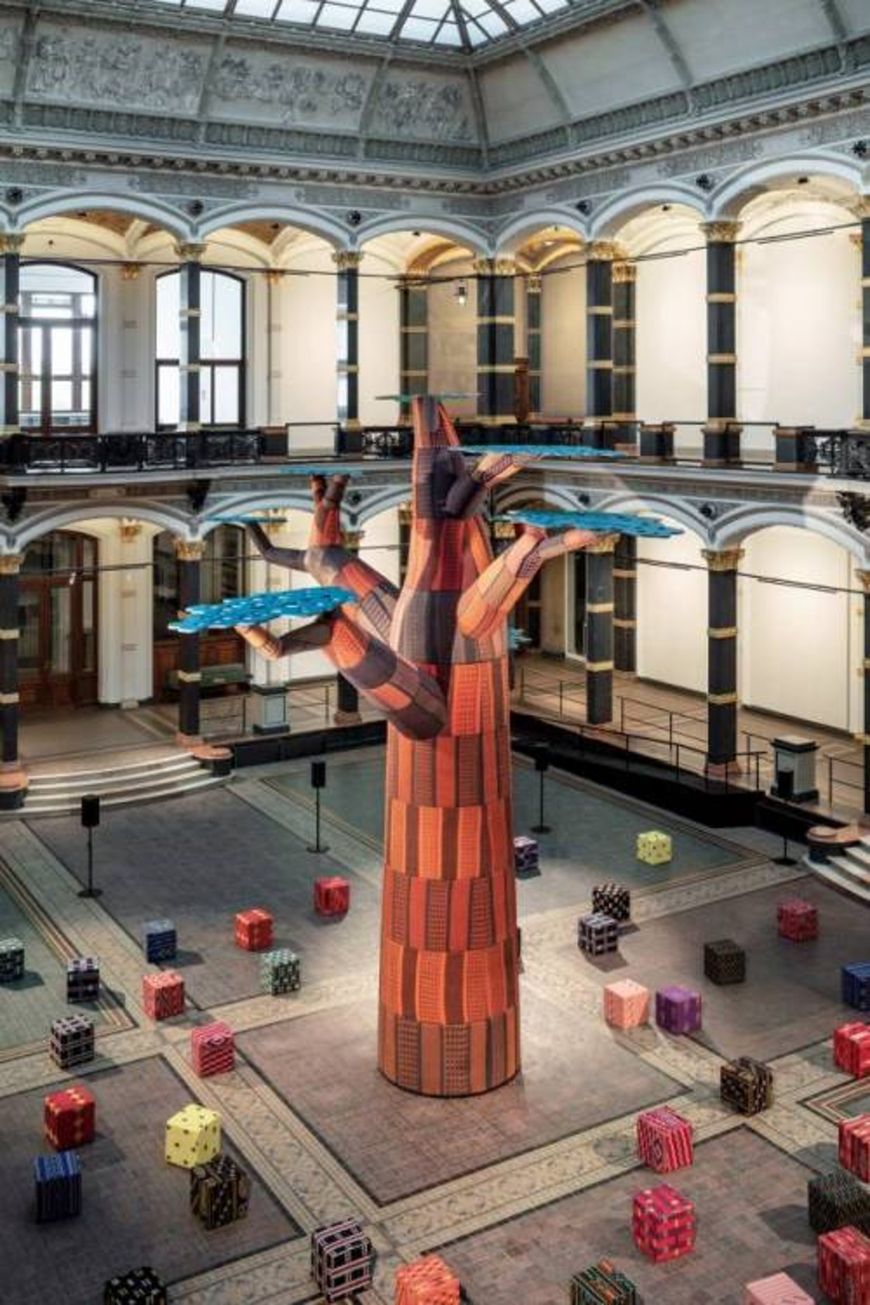Text | Essay | Gropius Bau 2022
To Catch a Vibe
Eric Otieno Sumba

In Igbo, the word Ámà denotes a site of knowledge and collectivity – a communal vibe. But bringing this archetype to Europe requires an awareness of clichéd visions of Africa, and an excavation of the sonic and haptic as vital challenges to Western modes of seeing the world. Writer and political economist Eric Otieno Sumba follows the wave.
Colloquially, vibe means “to chill, be at peace, and let life do its thing”, (1) while its plural form may refer to a general emotional feeling one has from another person, place or situation. Ubiquitous, yet also susceptible to “death” by malicious intent, the vibe is present when streaming a captivating series online (“This series is such a vibe”), or “dead” when a mishap ruins an otherwise good day (“The power cut killed my vibe”). The conceptual import of this contemporary figure of speech, whose root word vibration refers to “an instance of vibratory motion; oscillation; quiver; tremor” (2) is underestimated. Vibe, to borrow Elísio Macamo’s characterisation, is a “word that thinks (for us).” (3) It obscures our emotional illiteracy and stands in for numerous words that we would otherwise need to accurately convey the nuances of human emotion. Yet, vibe is also the ultimate contemporary signifier of the complex constellations of time, space and place that have fascinated natural and social scientists for centuries.
Physics has repeatedly provided models for the scientific study of the human condition, as Denise Ferreira da Silva reminds us in her 2016 essay “On Difference without Separability”. For instance, Georges Cuvier’s (1769–1832) initial framing of the “science of life”, modelled after Newton’s natural philosophy, relied on the descriptive mode of early natural history. Da Silva contends that Cuvier’s work introduced the notion of life as both the efficient and final cause of living things. Another example is the claim by anthropologist Franz Boas (1858–1942) that social – rather than biological – aspects account for the variation of moral and intellectual capability. For Da Silva, the anthropological school that Boas’ work inaugurated (cultural anthropology) marked a departure from ethnocentric views of human difference and resonated with a major shift in physics, namely Einstein’s principle of relativity. According to Da Silva, Michael Foucault’s microphysics of power also borrowed from Newton’s laws of motion to explain the role of language, discourse and institutions in the power/knowledge constellation for which he is widely known.
Far from inspiring “imaginings of difference without separability”, however, these theoretical and methodological approaches have further reinforced the idea that culture and its moral and intellectual benchmarks express a fundamental separation between human collectives of different nationality, ethnicity and social (gender, sexual, racial) identities. This view, which Da Silva describes as “the principle of separability” proposes that the social is constituted of formally separate parts, where each part comprises a social form and a geographically and historically separate unit. As a consequence, each of these separate units stands differentially before the ethical notions of humanity that are both particular and Eurocentric. (4)
Few geographies are as exposed to the principle of separability as rural Africa, commonly reified as the African “bush”, “jungle” or “savannah”. Despite hosting several large cities and conurbations, Africa is generally imagined as rural. In fiction, theatre and more recently film, the rural African landscape is cast as diametrically opposed to the “urbanness” and “modernity” that younger Africans readily claim for themselves, casually relegating adjacent contemporary landscapes to ancient history simply because they “lack” modernness. Viewed across the continent, popular films produced in Nigeria’s gargantuan film industry, Nollywood, (5) typically rely on tropes about rural Africa like several plays and novels before them. (6) A common one invests in the urban rural (or rural-urban) divide as a driver of conflict among family units, evoking the supposed purity, simplicity and separateness of rural life. In this narrative, influences that are external to the remote, pure and “good” village are threats to be grappled with (and rejected) by default.

Opening of writers week Bessie Head, Novelist from Botswana. 2 March 1984,
Outside of Africa, there is (still) sufficient demand for a contemporary geographical “heart of darkness” in which rituals and re-enactments of discovery and exploration can be conducted. (7) The commercialised fulfillment of this demand requires the reification of African landscapes in processes that are both ritualised and habitual. When not romanticised as a timeless idyll of deep orange sunsets for tourism and investment, rural Africa is specifically vilified as the apex of backwardness and antithesis of progress to justify bouts of benevolent developmentalism. Perpetually waiting for urbanisation and the electricity that brings light to the presumed heart of darkness, this landscape is imagined as devoid of depth and dimension despite mounting evidence to the contrary. (8) The commitment to this imaginary vast, flat and empty intellectual wasteland runs deep.
Some of the most formidable attempts to heave rural Africa out of these Eurocentric imaginaries of oblivion have remained relatively obscure. Kenyan writer Nanjala Nyabola seeks to revitalise the memory of an “insatiable correspondent” from rural Africa by referring to Bessie Head, the exiled South African writer who spent most of her life in rural Botswana. “No one writes about rural Africa with as much heart and complexity – at least not in English”, Nyabola notes in the essay “Bessie Head: A Life of Letters” (2018). (9) Like few others before Head, and even fewer since, Head’s rendering of rural life in Serowe in novels such as When Rain Clouds Gather (1968), Maru (1971) or A Question of Power (1973) was complex, Nyabola contends. “If her characters face some of the same situations as [Chinua] Achebe’s Okonkwo or Ngũgĩ [wa Thiong’o]’s Waiyaki, they do not collide with “colonialism” and “modernity”; they are not stick-figures on a grand historical tableau but fully formed humans grappling with the unexpected with remarkable depth. Head gives her characters the depth and gravitas often denied to rural life in Africa.” (10, 11)

Tina M. Campt, Listening to Images, Duke University Press, 2017
The core of Emeka Ogboh’s work at the Gropius Bau, Ámà: The Gathering Place (2021), is a twelve-channel sound installation emitted from speakers dispersed within the artist’s sculptural rendition of an Igbo village square in southeast Nigeria. Traditional Igbo songs, sung by a choir and recorded by the artist, bring the space to life in lieu of an actual recording of a village square soundscape. There is a method to this abstraction: Ogboh is in the intellectual company of Africans such as Nyabola and Head who earnestly grapple with the complexity of contemporary African life. Just as Head sought to complicate rural Africa in fiction, Ogboh distills quotidian soundscapes familiar to him, translating them for a new context while retaining their core elements. As much as Ogboh’s work typically relies on harnessing the defining sounds of aurally rich places such as Lagos, another layer of his work focuses on the intricate social derivatives of urban and rural soundscapes. Pivoting from sonority as a repository of codes, knowledge and contemporary forms of life, he probes how the social is engraved in the audible. Ogboh is connected to the worlds around him via sound. Its absence, particularly via anti-noise pollution ordinances that have privatised soundscapes, unsettles him. (12)
In her book Listening to Images (2017), Tina Campt invites us “to embrace a different understanding of “sound” – a scientific definition of sound as “frequency.” To a physicist, audiologist or musicologist, sound consists of more than what we hear. It is constituted primarily by vibration and contact and is defined as a wave resulting from the back-and-forth vibration of particles in the medium through which it travels.” Campt is curious about what she calls “felt sound”: ultra-low frequencies emitted by or audible only to certain animals, such as elephants and whales that audiologists call infrasound. She proposes “a haptic mode of engaging the sonic frequencies of photographs”, asserting that though infrasound is only perceivable in the form of vibrations, all sound is “an inherently embodied modality constituted by vibration and contact.” Consequently, infrasound explains those everyday practices that go unnoticed but that are an essential part of our environment and, for Campt, a site of cultural formation known as the “infra-ordinary”. This term, which describes minute situations, fleeting gestures, odd moments and ritualised habits overlooked in the presumptuous passive mode in which many go through life, is borrowed from L’Infra-ordinaire (The Infra-Ordinary), (13) a book by French writer Georges Perec published in 1989.
In the nominally quiet settings that host artworks across the Euro-Atlantic, sound in general, and a sound installation inspired by an Igbo village square in particular, are radical artistic interventions. Read through a faithful grasp of sonority, silence expels worlds and severs connection to place. In this view, silence is a nascent displacement – an abrogation of place. Taking sonority as place-making seriously, as well as the elements of collectivity (as collective activity) that constitute sound such as singing in a choir, the dynamics of collective use of space are exposed via reverse engineering of soundscapes. Inevitably, the transplantation of sonic landscapes from one cultural context to another must straddle between the essential and the universal if the vibe of the space is to be reproduced accurately. One must sort through individual elements of a soundscape to recover the rhythm, tone and texture of the place. At heart, Ámà: The Gathering Place is a study in vibes and how to “catch” them “well well”. (14) Ogboh breaks with the limited and limiting renditions of contemporary African rurality, universalising the village square by rendering its vibe legible beyond the tropes and the tropics.
In response to the reticence with which the subtitle of The Undercommons: Fugitive Planning & Black Study (co-authored with Stefano Harney, and published in 2013) was met, Fred Moten notes that “[s]tudy is what you do with other people. It’s talking and walking around with other people, working, dancing, suffering, some irreducible convergence of all three, held under the name of speculative practice.” (15) Moten adds that “being in a kind of workshop, playing in a band, in a jam session, or old men [sic] sitting on a porch, or people working together in a factory – there are these various modes of activity, the point of calling it ‘study’ is to mark that the incessant and irreversible intellectuality of these activities is already present […] to do these things is to be involved in a kind of common intellectual practise.” (16)

Emeka Ogboh, Ámà: The Gathering Place, 2021, installation view, Gropius Bau, Berlin,
It is in this vein that Berlin-based sound artist Lamin Fofana interrogates the transmutation of African aesthetics when they are transplanted to the West. Named for Sylvia Wynter’s eponymous unpublished manuscript from the 1970s, Fofana’s 2019 album Black Metamorphosis is the first in a trilogy of albums released under his label Black Studies. In acts of sonic translation, Fofana seeks to make audible the work of pioneering Black thinkers such as Wynter, W. E. B. Du Bois and Amiri Baraka. Fofana acts in recognition of a long tradition of Black thinkers who have disrupted ocularcentrism in art and life. Similarly, Ogboh’s studies of the public constitution of collectivity invoke the trails of universal wisdom passed via oratory codification across generations. These trails provide an indelible intellectual basis for Ogboh’s work, one that is on par with the work of the most illustrious Black thinkers, who themselves rely on this wisdom.
As a site where knowledge and collectivity is codified, the Ámà is a universal spatial archetype. Every activity that happens at this gathering place is equally important and constitutive to the space, no activity is more valuable than the other, none prioritised over another, evoking Moten’s musings on notions of study. The schedule, if any, is loose and flexible. Ámà embodies elasticity. It is a place that is available to contain whatever activity is deemed necessary and suitable to conduct at a given time. This, initially, may have been the variously abandoned ideal behind the concept of public space. When artists animate space with the audible yield of incidental (collected soundscapes) or planned (singing choir, composed music) collectivity, we recognise a recourse to repositories of knowledge and a need to parse them via overlapping sensory registers. Here is a decisive will to expel the “acoustical deadness” of space, evoking the narrator of Ralph Ellison’s 1952 novel, Invisible Man, who insists that “when I have music, I want to feel its vibration, not only with my ear but with my whole body.” (17)
Eric Otieno Sumba was born in Nairobi and grew up in Kenya’s North Rift. He is a writer, social theorist and political economist working at the intersections between social justice, anti-colonial politics, the global “order” and contemporary art and culture. Apart from his academic publications, he has contributed to two edited volumes: African Artists: From 1882 to Now, and Radical Reimaginings of Museums (forthcoming) as well as to publications including Contemporary And, Africa is a Country, Something We Africans Got, Sleek, Frieze, Nataal, Texte zur Kunst and Griotmag, where he is also contributing editor. He is a doctoral researcher at the Department of Development and Postcolonial Studies at the University of Kassel.
Endnotes(1) See: “Vibe”, Urban Dictionary, https://www.urbandictionary.com/define.php?term=Vibe (accessed 26 October 2021).
(2) See: “Vibration”, Dictionary.com, https://www.dictionary.com/browse/vibration (accessed 27 October 2021).
(3) Elísio Macamo, “Blinded by Capitalism: Words that think (for us)”, Review of African Political Economy, 7 December 2016, https://roape.net/2016/12/07/blinded-capitalism-words-think-us/ (accessed 26 October 2021).
(4) See: Denise Ferreira da Silva, “On Difference Without Separability”, exh. cat. 32nd Bienal De São Paulo Art Biennial: Incerteza viva (São Paulo, 2016), pp.57–65.
(5) This is also true for much older films produced in the first three decades of the post-independence period. An example is King Ampaw’s film Kukurantumi-Road to Accra (1983).
(6) Take, for example, Marjorie Oludhe Macgoye’s Coming to Birth (1986) to some extent, or Chinua Achebe’s Things Fall Apart (1958) is another example.
(7) Trophy hunting, for example.
(8) Awuor Onyango, “Silicon Savannah”, C& #11: Conscious Codes, Anyone? (2020)
(9) Nanjala Nyabola, “Bessie Head: A Life of Letters”, Poplar, 17 July 2018, https://popula.com/2018/07/17/bessie-head-a-life-of-letters/ (accessed 26 October 2021).
(10) Ibid.
(11) Yvonne Adhiambo Owuor’s novel Dust (New York: Knopf, 2014) matches Head’s dedication to creating complex characters even in rural African settings.
(12) Laura Helena Wurth, interview with Emeka Ogboh, “Lärm gehört dazu”, Der Freitag, 12 September 2021, https://www.freitag.de/autoren/der-freitag/laerm-gehoert-dazu (accessed 26 October 2021).
(13) Published in: Georges Perec, Species of Spaces and other Pieces (London: Penguin Books, 1997).
(14) “Well well” is Nigerian pidgin for properly.
(15) Stefano Harney and Fred Moten, The Undercommons: Fugitive Planning & Black Study (Wivenhoe, New York, Port Watson: Minor Compositions, 2013), p. 110.
(16) Ibid.
(17) See: Ralf Ellison, Invisible Man (New York: Random House, 1952).